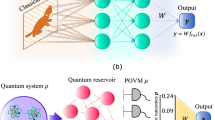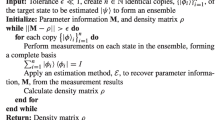Abstract
It is well known that quantum algorithms may solve problems efficiently that are intractable using conventional algorithms. Quantum algorithms can be designed with a set of universal quantum gates that transform input states into desired output states. However, designing quantum algorithms that transform states in desired ways is challenging due to its complexity. In this paper, we propose a machine learning framework for the transformation of unknown states into their corresponding target states. Specifically, a parameterized quantum circuit learns a given task by tuning its parameters. After the learning is done, the circuit is competent for the quantum task. This allows us to circumvent cumbersome circuit design based on universal quantum gates. If perfect transformation is forbidden by quantum theory, an optimal transformation can be obtained in terms of fidelity. This provides a research method to study various quantum no-go theorems that characterize the intrinsic gap between quantum and classical information. As examples, quantum state rotation and quantum state cloning are studied using numerical simulations. We also show the good robustness of our machine learning framework to corrupted training data, which is a very nice property for physical implementation on near-term noisy intermediate-scale quantum devices.










Similar content being viewed by others
References
Nielsen, M.A., Chuang I.L.: Quantum Computation and Quantum Information, p. 9781107002173 . Cambridge University Press, I.L. (2011)
Shor, P.W.: Polynomial-time algorithms for prime factorization and discrete logarithms on a quantum computer. SIAM J. Comput. 26, 1484 (1997)
Grover, L.K.: A fast quantum mechanical algorithm for database search. In: Proceedings of Twenty-eighth ACM Symposium on Theory of Computing, pp. 212–219 (1996)
Harrow, A.W., Hassidim, A., Lloyd, S.: Quantum algorithm for linear systems of equations. Phys. Rev. Lett. 103, 150502 (2009)
Yoo, S., Bang, J., Lee, C., Lee, J.: A quantum speedup in machine learning: finding an N -bit Boolean function for a classification. New J. Phys. 16, 103014 (2014)
Gisin, N., Popescu, S.: Spin flips and quantum information for antiparallel spins. Phys. Rev. Lett. 83, 432 (1999)
Bužek, V., Hillery, M.: Optimal manipulations with qubits: Universal quantum entanglers. Phys. Rev. A 62, 022303 (2000)
Bužek, V., Hillery, M.: Quantum copying: beyond the no-cloning theorem. Phys. Rev. A 54, 1844 (1996)
Gisin, N., Massar, S.: Optimal quantum cloning machines. Phys. Rev. Lett. 79, 2153 (1997)
Nielsen, M.A.: Conditions for a class of entanglement transformations. Phys. Rev. Lett. 83, 436 (1999)
Wang, M.-H., Cai, Q.-Y.: High-fidelity quantum cloning of two nonorthogonal quantum states via weak measurements. Phys. Rev. A 99, 012324 (2019)
Li, M.-S., Wang, Y.-L.: Masking quantum information in multipartite scenario. Phys. Rev. A 98, 062306 (2018)
Wootters, W.K., Zurek, W.H.: A single quantum cannot be cloned. Nature 299, 802 (1982)
Barnum, H., Caves, C.M., Fuchs, C.A., Jozsa, R., Schumacher, B.: Noncommuting mixed states cannot be broadcast. Phys. Rev. Lett. 76, 2818 (1996)
Barnum, H., Barrett, J., Leifer, M., Wilce, A.: Generalized no-broadcasting theorem. Phys. Rev. Lett. 99, 240501 (2007)
Oszmaniec, M., Grudka, A., Horodecki, M., Wójcik, A.: Creating a superposition of unknown quantum states. Phys. Rev. Lett. 116, 110403 (2016)
Modi, K., Pati, A.K., de Sen, A., Sen, U.: Masking quantum information is impossible. Phys. Rev. Lett. 120, 230501 (2018)
Carrasquilla, J., Melko, R.G.: Machine learning phases of matter. Nat. Phys. 13, 431 (2017)
Canabarro, A., Brito, S., Chaves, R.: Machine learning nonlocal correlations. Phys. Rev. Lett. 122, 200401 (2019)
Carleo, G., Cirac, I., Cranmer, K., Daudet, L., Schuld, M., Tishby, N., Vogt-Maranto, L., Zdeborová, L.: Machine learning and the physical sciences. Rev. Mod. Phys. 91, 045002 (2019)
Gammelmark, S., Mølmer, K.: Quantum learning by measurement and feedback. New J. Phys. 11, 033017 (2009)
Wiebe, N., Braun, D., Lloyd, S.: Quantum algorithm for data fitting. Phys. Rev. Lett. 109, 050505 (2012)
Rebentrost, P., Mohseni, M., Lloyd, S.: Quantum support vector machine for big data classification. Phys. Rev. Lett. 113, 130503 (2014)
Dunjko, V., Taylor, J.M., Briegel, H.J.: Quantum-enhanced machine learning. Phys. Rev. Lett. 117, 130501 (2016)
Biamonte, J., Wittek, P., Pancotti, N., Rebentrost, P., Wiebe, N., Lloyd, S.: Quantum machine learning. Nature 549, 195 (2017)
Mitarai, K., Negoro, M., Kitagawa, M., Fujii, K.: Quantum circuit learning. Phys. Rev. A 98, 032309 (2018)
Bukov, M., Day, A.G.R., Sels, D., Weinberg, P., Polkovnikov, A., Mehta, P.: Reinforcement learning in different phases of quantum control. Phys. Rev. X 8, 031086 (2018)
Schuld, M., Killoran, N.: Quantum machine learning in feature hilbert spaces. Phys. Rev. Lett. 122, 040504 (2019)
Cao, S.-X., Wossnig, L., Vlastakis, B., Leek, P., Grant, E.: Cost-function embedding and dataset encoding for machine learning with parametrized quantum circuits. Phys. Rev. A 101, 052309 (2020)
Cincio, L., Subaşi, Y., Sornborger, A.T., Coles, P.J.: Learning the quantum algorithm for state overlap. New J. Phys. 20, 113022 (2018)
Lin, J., Lai, Z.-Y., Li, X.-P.: Quantum adiabatic algorithm design using reinforcement learning. Phys. Rev. A 101, 052327 (2020)
Benedetti, M., Lloyd, E., Sack, S., Fiorentini, M.: Parameterized quantum circuits as machine learning models. Quantum Sci. Technol. 4, 043001 (2019)
Kandala, A., Mezzacapo, A., Temme, K., Takita, M., Brink, M., Chow, J.M., Gambetta, J.M.: Hardware-efficient variational quantum eigensolver for small molecules and quantum magnets. Nature 549, 242 (2017)
McClean, J.R., Boixo, S., Smelyanskiy, V.N., Babbush, R., Neven, H.: Barren plateaus in quantum neural network training landscapes. Nat. Commun. 9, 4812 (2018)
Schuld, M., Bergholm, V., Gogolin, C., Izaac, J., Killoran, N.: Evaluating analytic gradients on quantum hardware. Phys. Rev. A 99, 032331 (2019)
Dallaire-Demers, P.-L., Romero, J., Veis, L., Sim, S., Aspuru-Guzik, A.: Low-depth circuit ansatz for preparing correlated fermionic states on a quantum computer. Quantum Sci. Technol. 4, 045005 (2019)
Nakanishi, K.M., Fujii, K., Todo, S.: Sequential minimal optimization for quantum-classical hybrid algorithms. Phys. Rev. Res. 2, 043158 (2020)
Li, J., Yang, X.-D., Peng, X.-H., Sun, C.-P.: Hybrid quantum-classical approach to quantum optimal control. Phys. Rev. Lett. 118, 150503 (2017)
Buhrman, H., Cleve, R., Watrous, J., de Wolf, R.: Quantum fingerprinting. Phys. Rev. Lett. 87, 167902 (2001)
Bennett, C.H., Brassard, G.: Quantum cryptography: Public key distribution and coin tossing. In: Proceedings of IEEE International Conference on Computers, Systems, and Signal Processing, Bangalore, pp. 175–179. (1984)
Gisin, N., Ribordy, G., Tittel, W., Zbinden, H.: Quantum cryptography. Rev. Modern Phys. 74, 145 (2002)
Fan, H., Wang, Y.N., Jing, L., Yue, J.D., Shi, H.D., Zhang, Y.L., Mu, L.Z.: Quantum cloning machines and the applications. Phys. Rep. 544, 241 (2014)
Huttner, N.G.: Quantum cloning, eavesdropping and bell’s inequality. Phys. Lett. A 228, 13 (1997)
Bartkiewicz, K., Lemr, K., Cernoch, A., Soubusta, J., Miranowicz, A.: Experimental eavesdropping based on optimal quantum cloning. Phys. Rev. Lett. 110, 173601 (2013)
Niu, C.S., Griffiths, R.B.: Optimal copying of one quantum bit. Phys. Rev. A 58, 4377 (1998)
Cerf, N.J.: Pauli cloning of a quantum bit. Phys. Rev. Lett. 84, 4497 (2000)
Kingma, D., Ba, J.: Adam: a method for stochastic optimization. arXiv:1412.6980v5. (2014)
Acknowledgements
This work was supported by the National Natural Science Foundation of China (under Grant No. 12074107), Natural Science Foundation of Hubei Province of China (under Grant No. 2020CFB263), and the program for outstanding young and middle-aged scientific and technological innovation team of colleges and universities in Hubei Province (under Grant No. T2020001).
Author information
Authors and Affiliations
Corresponding author
Additional information
Publisher's Note
Springer Nature remains neutral with regard to jurisdictional claims in published maps and institutional affiliations.
Appendix
Appendix
We here give a derivation of the probabilities of measurement in Eqs. (12) and (15).
For QSR, the quantum circuit is shown in Fig. 4. Suppose that an input state \(|\psi _\mathrm{in}^i\rangle \) and the corresponding teaching state \(|\psi _{t}^i\rangle \) are fed into the quantum circuit. The \(|\psi _\mathrm{in}^i\rangle \) is sent through the learning circuit to give
The state before evaluation by the teaching circuit is
The first Hadamard gate on the last qubit gives us
Then, a controlled-SWAP gate is applied, which gives
Next, a Hadamard gate is applied again on the last qubit, giving
Finally, by measuring the last qubit, we obtain a result of 0 with probability
Similarly, we obtain a result of 1 with probability
For \(1-2\) QSC, the quantum circuit is shown in Fig. 6. Suppose that an input state \(|\psi _\mathrm{in}^i\rangle \) and the corresponding teaching state \(|\psi _{t}^i\rangle =|\psi _\mathrm{in}^i\rangle |\psi _\mathrm{in}^i\rangle \) are fed into the quantum circuit. The \(|\psi _\mathrm{in}^i\rangle \) together with auxiliary qubits are sent through the learning circuit to give
Suppose that \(|\psi _\mathrm{out}^i\rangle =\sum _{l,m,n=0}^{1} \alpha _{lmn}^{i}|l\rangle |m\rangle |n\rangle \). The state before evaluation by the teaching circuit is
The first two Hadamard gates on the last two qubits give us
Then, two controlled-SWAP gates are applied, which gives
Next, two Hadamard gates are applied again on the last two qubits, giving
It can be rewritten as
Thus, by measuring the last two qubits, we obtain a result of 00 with probability
Notice that \(\sum _{l,m,m',n}\alpha _{lmn}^{i}\alpha _{lm'n}^{*i}|m\rangle \langle m'|\) is the reduced density matrix of copy one, denoted as \(\rho _1\), \(\sum _{l,m,n,n'}\alpha _{lmn}^{i}\alpha _{lmn'}^{*i}|n\rangle \langle n'|\) is the reduced density matrix of copy two, denoted as \(\rho _2\). \(\sum _{l,m,m',n,n'}\alpha _{lmn}^{i}\alpha _{lm'n'}^{*i}|m\rangle |n\rangle \langle m'|\langle n'| \) is the reduced density matrix of copy one and two, denoted as \(\rho _{12}\). Then, \(p^{i}_{00}\) can be written as
Similarly, we can obtain
Rights and permissions
About this article
Cite this article
Zhao, TH., Wang, MH. & Zhou, B. Optimal quantum state transformations based on machine learning. Quantum Inf Process 20, 212 (2021). https://doi.org/10.1007/s11128-021-03148-3
Received:
Accepted:
Published:
DOI: https://doi.org/10.1007/s11128-021-03148-3




